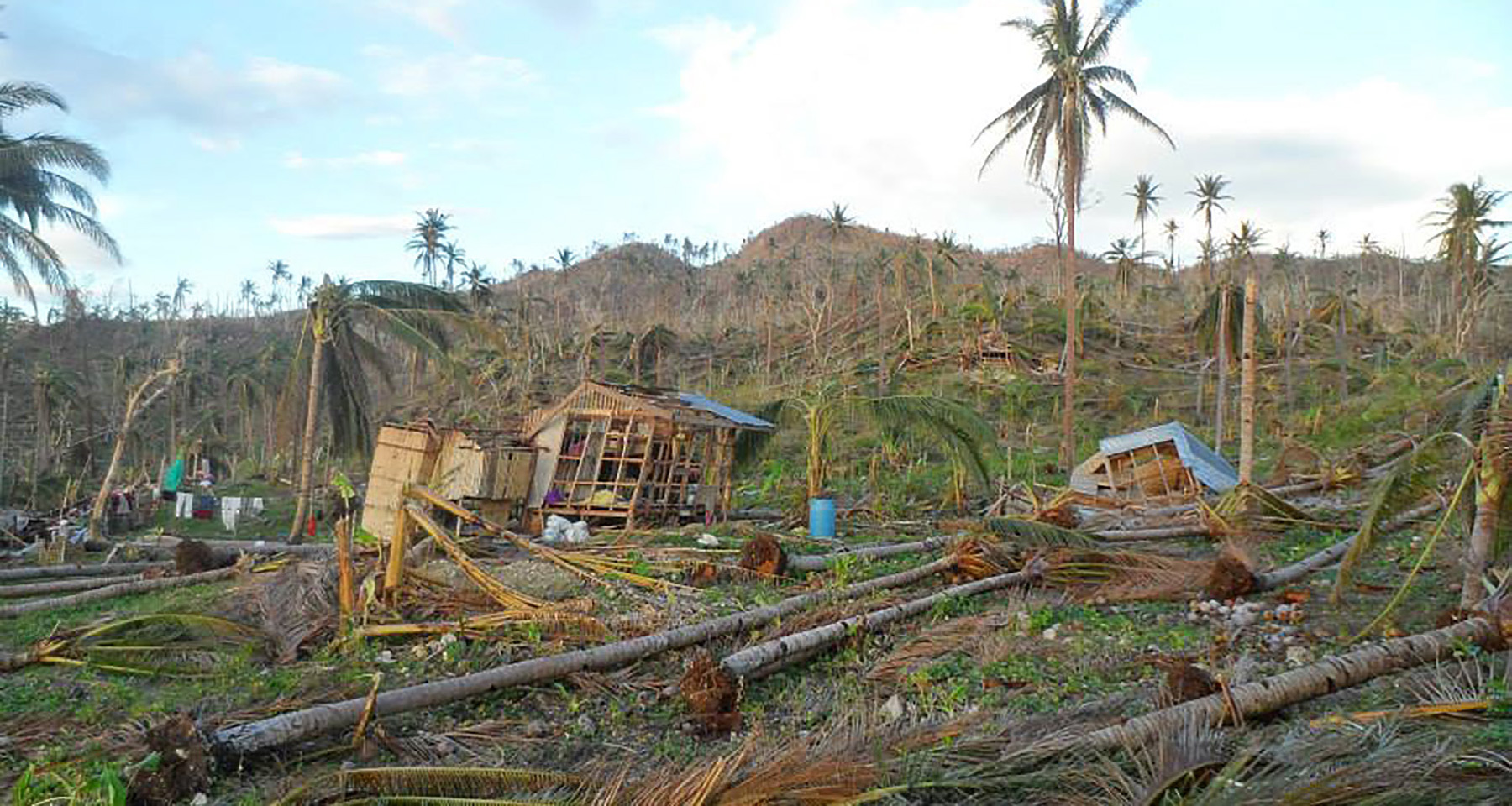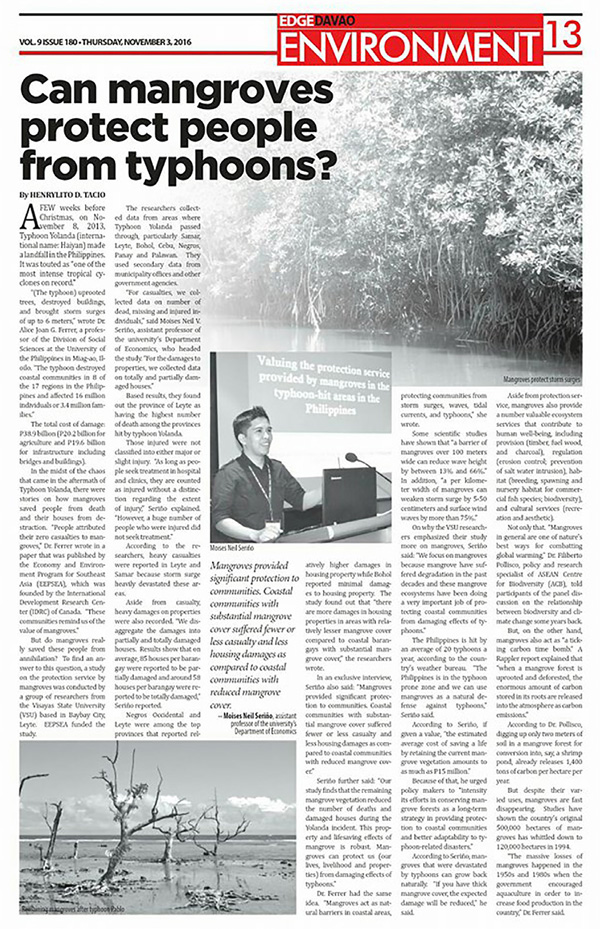Introduction
A few weeks before Christmas, on November 8, 2013, Typhoon Yolanda (international name: Haiyan) made landfall in the Philippines. It was touted as “one of the strongest typhoons to hit land.” Several islands in the central Philippines recorded tremendous losses in lives, property, and livelihood and the region experienced severe devastation due to strong winds and storm surges brought by the super typhoon.

Fig. 2 Damages caused by super typhoon Haiyan in our village. It destroyed our houses and coconut trees.
According to the National Disaster Risk Reduction and Management Council (NDRRMC 2015), super typhoon Haiyan devastated a total of 12,139 villages in 591 municipalities and 57 cities in 44 provinces, affecting mostly central Philippines. A total of 4.1 million people were displaced and an estimate of 6,293 casualties was recorded with 28,689 injured and 1,061 missing as of April 3, 2014 (NDRRMC 2015). The cost of damage was estimated to reach PHP 40 billion in agriculture, infrastructure, and private property damage (NEDA 2014).
On a personal level, the typhoon destroyed our village. Our house made of light materials was wiped out. In addition, the typhoon sent back coconut farming to year zero because most of coconut trees were cut by the damaging winds.
In the midst of the chaos that came in the aftermath of Typhoon Yolanda, there were stories on how mangroves saved people from death and their houses from destruction. Anecdotal reports and observations of local inhabitants in coastal villages have highlighted the usefulness of mangrove forests in reducing the damages brought by typhoon-related disasters. These personal accounts highlighted the undervalued protection service provided by mangroves. According to Das and Vincent (2009), protection against disasters related to typhoons has been identified as one of the important ecosystem services provided by mangroves.
But do mangroves really save these coastal villages from the destruction of super typhoon? To find an answer to this question, I, together with a diverse group of researchers from Visayas State University (VSU) based in Baybay City, Leyte in partnership with the Economy and Environment Program in Southeast Asia (EEPSEA), set out to find an answer. We collected data from areas where super typhoon Haiyan passed through; particularly in the islands of Samar, Leyte, Bohol, Cebu, Negros, Panay and Palawan. We used secondary data from municipality offices and other government agencies.
The team collected data from several coastal villages hit by super typhoon Haiyan and collected data on damages and mangrove cover. We carefully selected only those coastal villages with historical mangrove as part of the sample size because there were coastal areas where mangroves do not thrive. Villages where mangroves never occurred due to unfavorable ecological conditions were not included in the sample. We wanted to value the loss of mangroves and for loss to occur it should have existed in the first place. We used satellite data to confirm the presence or absence of mangrove cover in the coastal areas included in the study. For the historical mangrove presence, we relied on maps used by the US Army Map Service in 1944.

Fig.3 Estimated reduction in mangrove cover from 1944 to 2010.
Conversion of mangroves areas to aquaculture ponds and residential areas in the Philippines are the main causes of declining mangrove cover in the country (Primavera 2000). Mangroves have been disappearing in the country over the past decades and a significant reduction took place in the 1960s and 1970s. This is the same decade when aquaculture was encouraged by the government (Ferrer et al.2011). Figure 3 shows that there has been substantial reduction in mangrove cover. This is attributed to increasing anthropogenic activities in the coastal areas including urbanization, aquaculture, and the development of roads and reclamation areas that resulted in a huge reduction in mangrove area.
The undervaluation of mangrove ecosystem services leads to the continuous degradation of mangrove forests not just in the Philippines, but also globally. According to Valiela, Bowen, and York (2001), mangrove forests are one of the world’s most threatened major tropical environments. At least 35 percent of the world’s mangrove forests have been lost over the past two decades. Without changes in practices, policies, and perceptions of the values of mangroves, the trend in mangrove forest loss will likely continue.

Fig. 4 Focus group discussions with coastal communities presenting the results of our investigation.
To address the objective of this study, we used the damage cost approach in valuing the protection services provided by mangrove ecosystems against typhoon-related damage. This method takes into account the actual damage caused by super typhoons in areas with mangrove forests compared to the damage in areas with or without reduced mangrove forest. The damage cost approach evaluates the amount of damage that was averted due to the presence of mangroves or the damage that could have occurred if there had been no mangroves.
We used data on 384 coastal villages controlling for historical mangrove cover and other confounding village level characteristics in examining the influence of remaining mangrove vegetation on human deaths and housing damage. Results show that coastal villages with substantial mangrove cover suffered less damage compared to coastal villages with reduced mangrove cover. This life- and property-saving effects of mangroves is robust across several specifications suggesting that the remaining mangrove cover played a significant protective role when super typhoon Yolanda hit central Philippines. The estimated average cost of saving a life, by retaining the remaining mangrove vegetation, amounts to as much as USD $302,000 (PHP 15 million) while the estimated reduction in compensation for totally damaged houses is around USD $53,000.
Mangroves provided significant protection to communities. Coastal communities with substantial mangrove cover suffered fewer or lesser casualties and lesser housing damage as compared to coastal communities with reduced mangrove cover. Our study finds significant evidence on the protective function of mangroves implying that the remaining mangrove vegetation reduced the number of deaths and damaged houses during the Yolanda incident. Mangroves can protect us (our lives, livelihood and properties) from the damaging effects of typhoons.
Mangroves act as natural barriers in coastal areas, protecting communities from storm surges, waves, tidal currents, and typhoons. The Philippines is hit by an average of 20 typhoons a year, according to the country’s weather bureau. Results of the study suggests that we can use mangroves as a natural defense against the damaging effects of typhoons.

Fig. 5 News article presenting the results of the study.
Mangrove protection and conservation has generated renewed attention as one of the feasible approaches in providing protection to coastal communities. Policy makers should intensify their efforts to conserve mangrove forests as a long-term strategy in providing protection to coastal communities and better adaptability to typhoon-related disasters. This is because more frequent and stronger typhoons are to be expected due to climate change. Coastal communities and local governments should preserve and not further degrade remaining mangrove cover as there is compelling evidence of its protective function.
The results of the study have been presented to various agencies and local government units to campaign for mangrove protection and prevent further destruction in the remaining mangrove cover. The study is also featured in a magazine focusing on environmental issues. Results of the study have been published by EEPSEA. This study shows the importance of using natural resources as one of the feasible approaches in mitigating the adverse effects of climate change.
Moises Neil V. Seriño is an assistant professor and is currently the head of the Department of Economics based at Visayas State University (VSU), Visca, Baybay City, Leyte, Philippines. He earned his bachelor’s degree in statistics and took his MA in International Development at International University in Japan, Niigata in 2009. He finished his Doctorate in Economics at Göttingen University, Germany in 2014 under the supervision of Prof. Stephan Klasen. He teaches economic courses, econometrics, agricultural economics both at the graduate and undergraduate level. His research interests include a variety of topics including valuing protection services provided by mangroves, enhancing productivity among small-scale vegetable and coconut farmers, investigating climate resilient agricultural practices and determinants of household carbon emissions. Recently, he established a socio-economic research center based at VSU. The center helps in capacitating researchers in the Visayas region conduct socio-economic research.
References
- Das, S., and Vincent, J. R. 2009. Mangroves Protected Villages and Reduced Death Toll During Indian Super Cyclone. Proceedings of the National Academy of Sciences, 106(18): 7357–7360.
- Ferrer, A., Hopanda, J., Orquejo, M., Moscoso, A., and Sadaba, R. 2011. Reversion of Disused Fishpond Lease Agreement Areas to Mangrove Forest in Region VI, Philippines. Los Banos Laguna, Environment and Economy Program for Southeast Asia (EEPSEA).
- National Disaster Risk Reduction and Management Council (NDRRMC). 2015. Final Report on Effects of Typhoon “Yolanda” (Haiyan), Quezon City, Philippines. http://ndrrmc. gov.ph/attachments/article/1329/FINAL_REPORT_re_ Effects_of_Typhoon_YOLANDA_(HAIYAN)_06−09NOV2013. pdf. Accessed on August 2016.
- National Economic Development Authority (NEDA). 2014. The Philippines: Fifth Progress Report−Millennium Development Goals Executive Summary. National Economic Development Authority, Ortigas, Pasig City.
- Primavera, J. H. 2000. Development and Conservation of Philippine Mangroves: Institutional Issues. Ecological Economics 35: 91–106.
- Valiela, I., Bowen, J., and York, J. 2001. Mangrove Forests: One of the World’s Threatened Major Tropical Environments. BioScience 51(8): 807–15.
